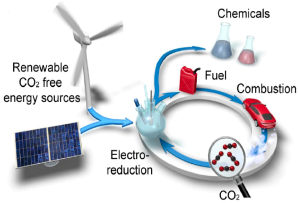For CO2 electrolysis gas diffusion applications, electrodes are typically made on top of either a carbon support that is coated in PTFE or an expanded PTFE support. For a carbon-based support the gas diffusion electrode has through plane conductivity so a current collector and a flow field act as the electrical path for electrons between the power source and the catalyst surface. Increasing the hydrophobicity of the gas diffusion layer by replacing the carbon support with expanded PTFE has been shown in prior art to increase the CO2 electrolysis performance. However, it requires the use of a front-contact. Typically, front contacts are either copper tape covered with Kapton or copper wires which have poor electrical conductivity and high contact resistance. To effectively convert CO2 to useful materials electrochemically, there must be better front contacts than what is currently available.
LLNL’s researchers use physical vapor deposition (sputter deposition or electron beam deposition) to coat an inert gasket material (i.e. PTFE) with a conductive metal (i.e. copper). The gas diffusion electrode overlaps onto the copper coated gasket to allow for electrical conductivity between the catalyst surface and the flow field/current collector of a CO2 electrolyzer. The coated gasket also provides proper sealing.
LLNL’s invention overcomes the current limitation by having all sides of the gas diffusion electrode in direct contact with pure copper that is in turn in contact with the flow field. The increased contact points, coupled with reasonable compression (80 PSI) allows the invention to reach cell voltages that are the same as if a carbon-based gas diffusion layer was used.
- Avoids need for multiple points of contact.
- Doesn’t require high cell voltages.
- Eliminates high contact resistances.
- CO2 electrolyzers
- Fuel cells
Current stage of technology development: TRL 3
LLNL has filed for patent protection on this invention.


